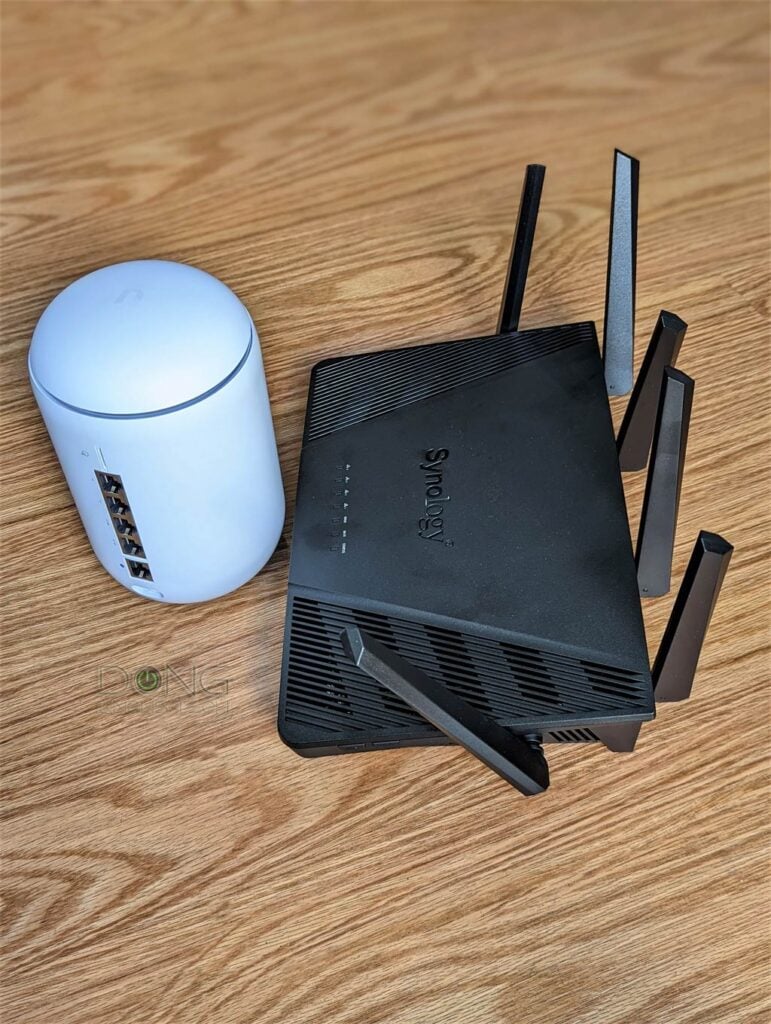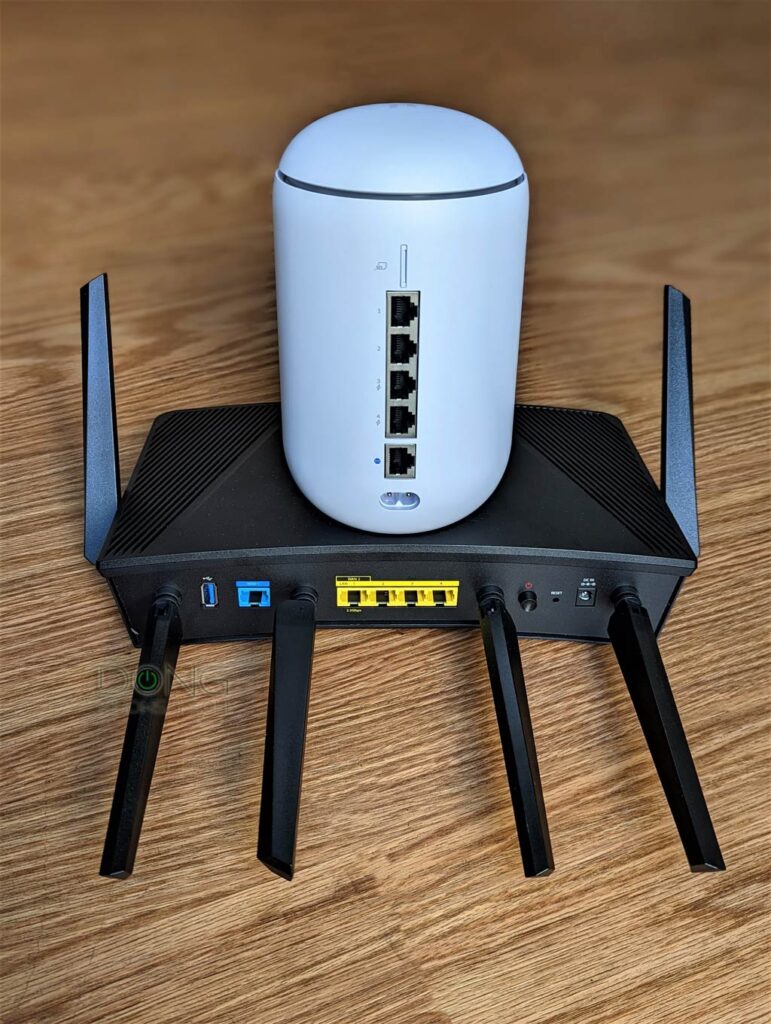Synology RT6600ax vs Ubiquiti UDR: Solid Rivals
[ad_1]
The Synology RT6600ax and Ubiquiti UDR (UniFi Dream Router) appear to have nothing in common. They have distinctive looks and belong to two approaches regarding home/(semi-)professional networking.
But I couldn’t help thinking of the latter while testing the former, which arrived later in the Wi-Fi 6 game — both were kind of late.
This Synology RT6600ax vs Ubiquiti UDR matchup will explain that sentiment and when though, and you might realize that the two turned out to have more common than they do in differences.
In any case, make sure you read their in-depth reviews for more.

Synology RT6600ax vs Ubiquiti UDR: The potentially common experience in two different Wi-Fi approaches
From the photo above, it’s safe to say you can’t mistake the Synology RT6600ax for the Ubiquiti UDR or vice versa. One looks like a smart speaker, while the other has the traditional design of a typical Wi-Fi router.
Ubiquiti: UniFi vs AmpliFi
UniFi and AmpliFi are two major networking product lines from Ubiquiti. They serve two demographics and therefore have different architectures and separate mobile apps and web user interfaces.
The UniFi family — represented by the Dream Machine (UDM), UDM-Pro, UDM-SE…, or the Dream Router (UDR) — aims at business/pro users. They are comprehensive routers that can also function as the central controllers of various products.
On the other hand, the AmpliFi family, represented by the HD Wi-Fi system or the Alien, is for the home environment. They are simple Wi-Fi routers, ease-to-use but with a limited feature set.
The UDM is the first UniFi product that also works well as a home router, thanks to the friendly design. In a way, it’s a bridge between the two product lines. And the UDR further solidifies that approach.
Still, Ubiquiti’s UniFi products can be overwhelming and overkill in many cases. Generally, home users should go with AmpliFi instead of UniFi.
But they are different on the inside, two. Let’s check out their hardware specs.
Synology RT6600ax vs Ubiquiti UDR: Hardware specifications
| Name | Synology RT6600ax Tri-band Wi-Fi 6 Router | Ubiquiti UniFi Dream Router |
| Model | RT6600ax | UDR |
| Wi-Fi Technology | Tri-band AX6600 | Dual-band AX3000 |
| 1st Band (2.4GHz) |
2×2 AX Up to 600Mbps (20/40MHz) |
2×2 AX Up to 600Mbps (20/40MHz) |
| 2nd Band (5GHz) |
4X4 AX Up to 4804 Mbps Upper channels (20/40/80/160MHz) |
2×2 AX Up to 2.4Gbps (20/40/160MHz) |
| 3rd Band (5GHz) |
2×2 AX Up to 1200 Mbps Lower channels (20/40/80MHz) |
None |
| 5.9GHz Support | Yes | No |
| Backward Compatibility | 802.11a/b/g/n/ac | 802.11a/b/g/n/ac |
| AP Mode | Yes | Yes |
| Mesh-ready | Yes (Synology Mesh) | Yes |
| Additional Role | Mini NAS server | Hardware Controller |
| Other Hardware Support | USB drives (as NAS storage) Other Synology Mesh Routers (as satellites) |
Network: Up to 15 UnFi APs or extenders as mesh satellites. Plus one of the following: Protect: Up to 4 HD cams or one 4K cam. Or Talk: Up to 25 IP phones. Or Access: Up to 50 doorbells |
| Gigabit Port | 1x WAN (permanent) 3x LAN |
1x WAN 4x LAN |
| PoE Port | None | LAN1 and LAN2 (802.3af) |
| Multi-Gig Port | 1x 2.5Gbps WAN/LAN | None |
| Dual-WAN | Yes (WAN + 2.5Gbps or cellular) | No |
| USB | 1x USB 3.0 | None |
| Firmware Version (at review) |
SRM 1.3-9193 | OS version 2.4.9 |
| Mobile App | Android and iOS: DS Router, VPN Plus, DS cloud, DS file, Android-only: DS Get (Download) |
UniFi |
| QoS | Yes | Yes |
| Parental Control | Yes | Yes |
| Processing Power | 1.8 GHz Quad-core CPU, 1GB RAM | Dual-Core Cortex A53 1.35 GHz CPU, 2GB RAM |
| Internal Storage | 256MB Flash | Internal 128GB Flash, SD card slot for a 128GB larger card |
| Internal Fan | No | Yes (Very quiet) |
| Built-in Online Protection | Yes | Yes |
| Dimensions (antennas up) |
16.9 x 12.6 x 7.9 in (175 x 320 x 200 mm) |
4.33-inch (110 mm) wide 7.25-in (184.2 mm) tall |
| Weight | 2.65 lbs (1.2kg) | 2.54 lb (1.15 kg) |
| Power Specs | 100 -240V AC | 100 -240V AC |
| Power Consumption (per 24 hours) |
≈ 280 Wh | ≈ 228 Wh |
| Release Date | May 11, 2022 | April 26, 2022 |
| Price (at launch) |
$299.99 | $199 |
Differences that make them a similar experience
From the table above, you’ll see that the UDR is of lesser Wi-Fi specs. It’s a Dual-band AX3000 router vs Tri-band 6600ax in the case of the RT6600ax.
Furthermore, the RT6600ax is the first router on the market to support the 5.9GHz portion of the 5GHz band, making it the first complete Wi-Fi 6 router.
But that’s the only area where the Synology is decidedly better.
(More) differences in hardware
On the network port front, the Synology has a 2.5Gps port, but the UDR uniquely supports PoE. Both are different in nature but are equally significant in applications.
The RT6600 has a USB port and can work as a mini NAS server when hosting an external drive. And in this case, it’s the next best thing after a real Synology NAS server.

On the other hand, the UDR, while having no USB port, comes with 128GB of internal storage and an SD card slot to host even more — it doesn’t need no USB, so to speak.
Most importantly, apart from a Wi-Fi access point (or extender), it’s also the native controller and the network video recorder (NVR) for a large selection of other hardware, including IP phones, security cameras, smart doorbells, etc.
Differnces in firmware
The Synology R6600ax runs Synology Router Manager (SRM) version 1.3, which is one of the best, if not the best, standard firmware for routers. SRM is Linux-based and functions similarly to a native operating system within its web user interface.

The OS allows for half a dozen add-on packages that add more functions and features to the router. Some of these packages have a mobile app of their own, making the RT6600ax the most versatile Wi-Fi router.
Regarding management, the RT6600ax doesn’t require a login account, and users can manage it remotely via Dynamic DNS. On top of that, the router also features Synology’s QuickConnect as an option.
The Ubiquiti UDR, on the other hand, runs Ubiquiti’s proprietary firmware that requires a login account to work, both via the UniFi mobile app and the web user interface.
Nonetheless, the firmware is enterprise-grade and has a unified approach to the UniFi ecosystem. As a result, if you have used an Unifi device before, you’ll be at home with the UDR.

Most importantly, no matter how many hardware units or types of hardware you choose to use with the UDR, you only need a single UniFi mobile app to control them all in one place.
And when you get hardware of the same family, things will just work. The firmware is very well-designed and proved to be very easy to use despite the complexity of the UniFi ecosystem.
Synology RT6600ax vs Ubiquiti UDR: Performances and ratings
Both the RT6600ax and UDR are excellent performers of their Wi-Fi specs. And the two also enjoy equally high ratings among all Wi-Fi 6 routers I’ve tested.

Pros
Fast and reliable Wi-Fi with the support for 5.9GHz UNII-4 spectrum, mesh-ready
Robust, comprehensive yet user-friendly SRM 1.3 firmware with excellent web interface and DS Router app
Lots of useful built-in settings and networking features, helpful add-on packages with accompanying mobile apps
Can work as a full-featured NAS server
Practical design, wall-mountable
Cons
No Link Aggregation, awkward Multi-Gig WAN, rigid default WAN port
Only client-based QoS, 5.9GHz clients are scarce

The numbers shown are from the best-case scenario. Specifically, the UDR was tested with its Threat Detection turned off and the RT6600ax with USB 2.0 mode.
As a better-specced router, the Synology RT6600ax easily beats the Ubiquiti UDR in wireless throughputs. However, considering the UDR is the controller of many hardware types, Wi-Fi is just one of its many functions.

Pros
Built-in support for all of Ubiquiti’s business hardware segments (Network, Protect, Talk, and Access)
Reliable Wi-Fi performance, excellent range, mesh-ready
Tons of useful networking features, comprehensive web user interface, and mobile app
Compact and beautiful design, two PoE ports
Comparatively affordable, quiet operator
Cons
No Multi-Gig, Dual-WAN, or Link Aggregation; middling Wi-Fi specs and modest processing power
Security feature reduces Wi-Fi 6 speed, Power over Ethernet doesn’t support PoE+ or PoE++
Requires an account with UniFi, not wall-mountable, internal fan
Conclusion
The Synology RT66000ax and Ubiquiti UDR represent two different approaches to networking.
Synology is learning standard and open. It gives users more control over the hardware, especially in local and remote management.
Ubiquiti, on the other hand, is going fully proprietary. Users have less control over what hardware to use, but within the ecosystem, they just work.

Strictly in terms of (home) Wi-Fi routers, though, I’d pick the Synology RT6600ax over the Ubiquiti UDR. However, as networking hardware, I like both equally — the UDR can do much more than just a simple Wi-Fi broadcaster.
In any case, these two are excellent networking devices, well worth their costs, and possibly even more for suitable needs.
In any case, you only need one. If you get both, they will not play nice together in any meaningful way.
[ad_2]
Source link
